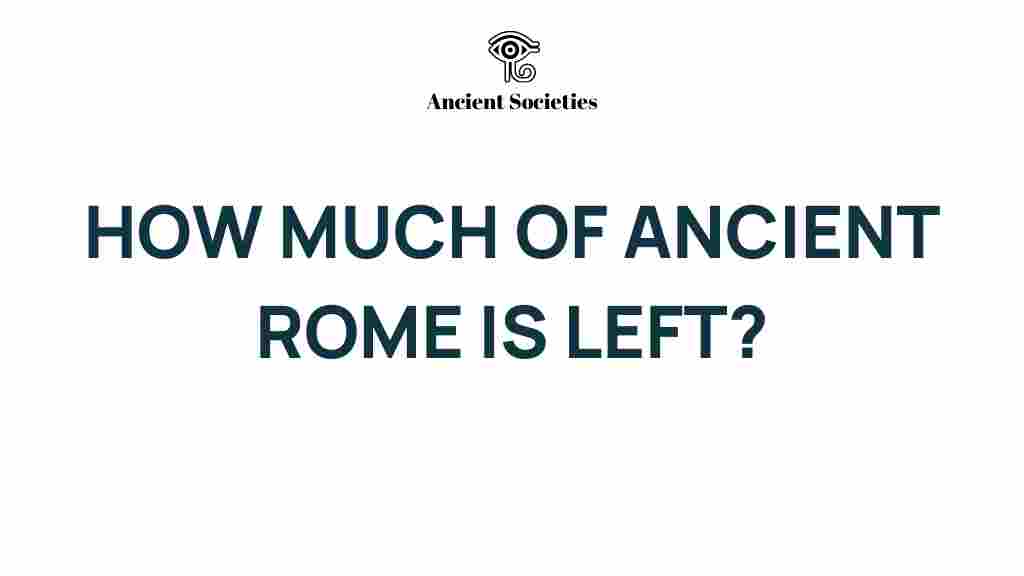Unveiling the Remnants: How Much of Ancient Rome Endures Today?
Ancient Rome has long captivated the imagination of historians, archaeologists, and travelers alike. As one of the most significant civilizations in history, the Roman Empire left a profound impact that continues to resonate in our modern world. From sophisticated engineering feats to rich cultural heritage, the remnants of Ancient Rome serve as a testament to its enduring legacy. In this article, we will explore the archaeological remnants of Ancient Rome, examine historical sites, and discuss the importance of preservation for future generations.
The Rich Tapestry of Roman History
The history of Ancient Rome spans over a millennium, beginning with its founding in 753 BC and culminating with the fall of the Western Roman Empire in AD 476. During this time, Rome transformed from a small settlement into one of the most powerful empires in history. The influence of Ancient Rome can be seen in various aspects of modern society, including governance, architecture, language, and law.
Archaeology: Unearthing the Past
Archaeology plays a critical role in understanding the remnants of Ancient Rome. Through careful excavation and analysis, archaeologists have uncovered a wealth of information about Roman life, culture, and society. Some key archaeological sites include:
- The Colosseum: This iconic amphitheater, built in AD 70-80, is a symbol of Roman architecture and engineering prowess. It could hold up to 80,000 spectators and hosted various events, including gladiatorial games.
- The Roman Forum: Once the heart of political, commercial, and social life in Ancient Rome, the Forum is a sprawling complex of ruins that includes temples, basilicas, and public spaces.
- The Pantheon: Originally built as a temple to the gods, the Pantheon boasts a magnificent dome and is one of the best-preserved buildings from Ancient Rome, showcasing the ingenuity of Roman engineering.
Preservation Efforts: Safeguarding Cultural Heritage
The preservation of Ancient Rome’s ruins is of utmost importance for cultural heritage. As time progresses, these structures face threats from natural decay, urban development, and tourism. Various organizations and governments have initiated preservation efforts to protect these historical sites:
- Conservation Projects: Many sites undergo restoration and conservation projects to stabilize the structures and prevent further deterioration. This includes cleaning, reinforcing, and sometimes reconstructing damaged sections.
- Legal Protections: Italian laws protect archaeological sites, ensuring that any development around them is carefully monitored and managed to minimize impacts.
- Public Awareness Campaigns: Educating the public about the significance of these sites fosters a sense of responsibility toward their preservation.
Urban Exploration: Discovering Hidden Gems
Urban exploration has gained popularity among enthusiasts seeking to uncover lesser-known remnants of Ancient Rome. While many people flock to well-known landmarks, there are numerous hidden gems that tell the story of Rome’s rich past:
- The Catacombs: An extensive network of underground burial sites, the Catacombs of Rome provide insight into early Christian practices and Roman funerary customs.
- Trajan’s Market: Often considered the world’s oldest shopping mall, Trajan’s Market showcases the commercial life of Ancient Rome.
- Palatine Hill: As the mythical birthplace of Rome, Palatine Hill features ancient palaces and gardens, offering a glimpse into the lives of Rome’s elite.
Step-by-Step Process: Exploring Ancient Rome
For those looking to embark on a journey through the remnants of Ancient Rome, here’s a step-by-step guide:
- Plan Your Trip: Research the key historical sites and archaeological parks you want to visit. Consider the best times to go and any special events or exhibitions.
- Book Guided Tours: Many sites offer guided tours that provide in-depth knowledge and access to areas that may be restricted to the general public.
- Wear Comfortable Footwear: Exploring ancient ruins can involve a lot of walking on uneven surfaces. Comfortable shoes are essential for an enjoyable experience.
- Document Your Journey: Bring a camera or journal to capture your thoughts and memories. Many sites have breathtaking views and intricate details worth noting.
- Respect the Sites: Follow all rules and regulations at historical sites. Avoid touching artifacts or climbing on ruins to help with preservation efforts.
While exploring Ancient Rome can be an unforgettable experience, there may be some challenges along the way. Here are a few troubleshooting tips:
- Language Barrier: If you’re not fluent in Italian, consider downloading translation apps or bringing a phrasebook to help communicate.
- Weather Conditions: Be prepared for changes in weather. Bring layers, sunscreen, and water, especially during the hot summer months.
- Crowds: Popular sites can become crowded, particularly during peak tourist season. Try to visit early in the morning or late in the afternoon for a better experience.
- Accessibility: Some ruins may not be wheelchair accessible. Check accessibility options in advance if needed.
Conclusion: The Enduring Legacy of Ancient Rome
The remnants of Ancient Rome are more than just ruins; they are a window into a civilization that shaped the course of history. Through archaeology and preservation efforts, we can continue to learn from and appreciate the cultural heritage of the Roman Empire. Whether you’re standing in the shadow of the Colosseum or wandering through the winding streets of the Roman Forum, the echoes of Ancient Rome linger, reminding us of the greatness that once was.
For those interested in delving deeper into the history and archaeology of Ancient Rome, various resources are available, including books, online courses, and guided tours. Explore more about the history of Ancient Rome here.
Additionally, to stay updated on archaeological discoveries and preservation efforts, you can check out the official Archaeological Park of the Colosseum website.
This article is in the category Archaeology and created by AncientSocieties Team
